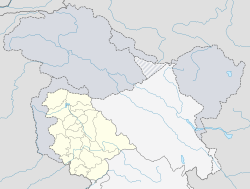Bashohli
|
Basholi Basohli,Basoli |
|
|---|---|
| Town | |
| Nickname(s): Basohli | |
| Location in Jammu and Kashmir, India | |
| Coordinates: 32°30′N 75°49′E / 32.50°N 75.82°ECoordinates: 32°30′N 75°49′E / 32.50°N 75.82°E | |
| Country |
|
| State | Jammu and Kashmir |
| District | Kathua |
| Elevation | -200 m (−700 ft) |
| Population (2014) | |
| • Total | 1 |
| Languages | |
| • Official | Dogri,Hindi |
| Time zone | IST (UTC+5:30) |
| Website | www.basohli.in/www.pinglamata.org |
Basholi (Basoli) is a town in Kathua district in the state of Jammu and Kashmir, India. It is situated on the right bank of River Ravi at an altitude of 1876 ft. It was founded by Raja Bhupat Pal sometime in 1635. It was known for magnificent places which are now in ruins and miniatures paintings (Basohli Paintings).
Basholi is located at 32°30′N 75°49′E / 32.50°N 75.82°E. It has an average elevation of 460 metres (1509 feet). Basoli is situated in the uneven lofty hills of Shiwaliks. It is situated in the right bank of Ravi river. Basoli has become popular for the Thein dam which has made it almost landlocked.Before the construction of Ranjit Sagar dam or Thein dam Basoli was just 32 km from Kathua but now due the dam it is about 72 km from Kathua city.
At the 2001 India census, Bashohli had a population of 12356. Males constituted 53% of the population and females 47%. Bashohli had an average literacy rate of 77%, higher than the national average of 59.5%; with 57% of the males and 43% of females literate. 12% of the population was under 6 years of age.
Hindu 83.01%, Muslim 16.38%,
Basholi is widely known for its paintings called Basholi paintings, which are considered the first school of Pahari paintings, and which evolved into the much prolific Kangra paintings school by mid-eighteenth century. The painter Nainsukh ended his career in Basholi.
Radha and Krishna in Discussion, (An illustration from Gita Govinda) Gouache on paper (ca.1730).
Goddess Bhadrakali, adored by the Gods. Basohli. India. c 1660-70.
Maharaja Sital Dev of Mankot in , Ink, opaque watercolor, and silver on paper (ca. 1690).
...
Wikipedia


